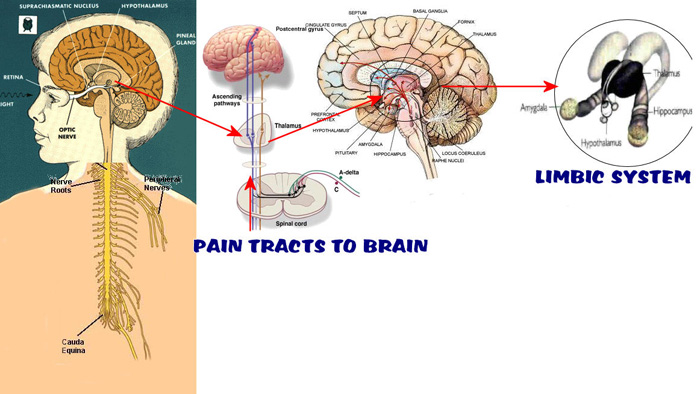
Let me start with this in mind: Everything begins somewhere. Most pain patients will say that "I was totally fine until this or that happened". The truth is that pain begins at birth. It is part of life and all we experience. One should read a great book by Paul Brand, MD entitled The Gift of Pain to appreciate how much the sensation of pain plays in our life and its importance. We tend to think of our youth and can not accept the pains of experience, injury, and aging. If this takes place, then one will fail to understand how everything in one's life plays a part in Chronic Pain.
So how is pain processed? It is not a simple reflex reaction like a light bulb going on when a switch is pressed. It is a complex process that takes sensations from the body in varying degrees and processes them. We then integrate and interpret our experience. The central processor of pain is the limbic system deep inside the brain. In a simplified model, the sensations of the body come up the spinal cord and are modulated by this Limbic System. The Limbic System also controls mood, emotions, sex and vitality, rage or anger, fear or anxiety, and the integration of recent memory. It directly controls one's biological rhythms, which include the sleep-wake cycles, hormonal cycles, and stress cycles. It controls the hormone axis (the pituitary gland and other glands), and the autonomic nervous system. The autonomic nervous system are those nerve pathways that control the heart rate, breathing, muscle tension, and bowel rhythms.

REMEMBER! The Limbic System is the central processor or controller of pain! It is located deep in the substance of the brain, and can be described as the "animal" or "primitive" brain.
So what affects the experience of pain? It is mood, emotions, rage, fear, memory, biological rhythms, and sex/vitality, along with the sensations that are transmitted up the cord through the various pain sensation nerve pathways. The feeling of pain is the complex result of all these components and more. It involves higher brain functions and the whole body. But the "Limbic System" is the key to treatment and getting better.
Now, this model makes a lot of sense for most patients with chronic pain of all types. It is common sense that: lack of sleep makes pain worse, anger makes pain worse, anxiety and stress makes pain worse, and depression makes pain worse.
Another very important thing to keep in mind: Not all sensations that are uncomfortable or discomforting are pain!!
I like to break up these feelings into those that are uncomfortable, those that are discomfortable, and those that are pain.
Uncomfortable feeling are those which trigger THE FEAR MATRIX and THE RAGE MATRIX. Examples are those feelings one gets around certain toxic people or toxic situations, where triggers are pulled and boundaries are violated.
Discomfort are those situations where one exerts themselves too much or does things that are required but are hard to do. Examples are working in the yard in the hot sun, walking more than one is conditioned to walk, or making an effort at doing a chore, hobby, passion and your physical limits are being challenged. Another key part of discomfort is aging and other natural processes that are part of life, such as arthritis.
Pain is a complex feeling that is experienced only by the pain patient and can not be judged as it is different for everyone. The goal is to NOT call those uncomfortable and discomfortable feelings (that are part of life) PAIN that may be treated with narcotics (opioids). These are treated by others modalities such as process therapy, pain behavioral management, and sometimes with medications.
EMOTIONS and MOOD can be treated with these modalities and quite successfully. So can RAGE and FEAR (which are agitation, anger, irritability, anxiety, fear, dread, loss of self and self confidence).
